Performance Evaluation of Complex Equipment Considering Resume Information
Abstract
:1. Introduction
2. Problem Formulation
2.1. Related Work
2.2. Problem Formulation
3. Evaluation Method of Equipment Performance Based on ER Rules
3.1. Input Information Transformation
3.2. Determination of Weight and Reliability
3.3. Information Fusion Based on ER Rules
3.4. Performance Evaluation Steps of Complex Equipment System
4. Case Study
4.1. Information Transformation Technique
4.2. Weight and Reliability Calculation
4.3. IMU Performance State Evaluation
4.4. Comparative Analysis
5. Conclusions
Author Contributions
Funding
Institutional Review Board Statement
Informed Consent Statement
Data Availability Statement
Conflicts of Interest
References
- Cui, Y.F.; Zhong, W.D.; Liu, D. Intelligent industrial equipment operating system technology and innovation. Zte Technol. 2017, 23, 56–60. [Google Scholar]
- Tang, X.L.; Qin, Y.N.; Pan, J.P.; Liu, J. Health management and key function analysis of industrial equipment. Lift. Transp. Mach. 2022, 9, 16–20. [Google Scholar]
- You, G.R.; Tan, Y.J. On the Research Requirements of Weapon and Equipment System. Mil. Oper. Res. Syst. Eng. 2012, 26, 15–18. [Google Scholar]
- Fan, Y.P.; Guo, Q.S.; Mu, G.; Song, J.H. Complexity of the demand development of weapons and equipment systems and their solutions. Syst. Eng. Electron. Technol. 2014, 36, 1320–1326. [Google Scholar]
- Zeng, Z.; Li, B.; Han, C.; Wu, W.; Wang, X.; Xu, J.; Zheng, Z.; Ma, B.; Hu, Z. An exergoeconomic analysis of a gas-type industrial drying system of black tea. Entropy 2022, 24, 655. [Google Scholar] [CrossRef]
- Xie, W.J. Development of Industrial Equipment State Detection System Based on Industrial Internet of Things; Harbin University of Science and Technology: Harbin, China, 2021. [Google Scholar]
- Chen, L.Y.; Zhou, Z.J.; Tang, S.W.; Cao, Y. Equipment performance evaluation method integrated with multiple information. Syst. Eng. Electron. Technol. 2020, 42, 1527–1533. [Google Scholar]
- Leiyu, C.H.; Zhijie, Z.H.; Changhua, H.U.; Ruihua, Y.U.; Zhichao, F.E. Performance evaluation of complex systems using evidential reasoning approach with uncertain parameters. Chin. J. Aeronaut. 2021, 34, 194–208. [Google Scholar]
- Hu, Z.G. Performance Evaluation Theory and Test Verification of the Beidou Navigation Satellite System; Wuhan University: Wuhan, China, 2013. [Google Scholar]
- Ni, Y.D.; Yi, M.H.; Liu, R.H.; Beidou, L.C. Dual-band navigation signal modulation mode and performance evaluation. J. Aeronaut. Sci. 2022, 44, 1–17. [Google Scholar]
- Wu, J.J.; Huang, H.S.; Zhang, S.S. Research on the quality traceability of the manufacturing process posted under the electronic resume. Mech. Des. Manuf. 2022, 6, 92–95. [Google Scholar]
- Dong, X.H.; Zhou, Z.J.; Hu, C.H.; Tang, S.W.; Wang, J. Optimal maintenance method of laser inertial group based on evidence inference. Meas. Control. Technol. 2020, 39, 63–68. [Google Scholar]
- Xiong, C.Y.; Liu, Y. The earthquake performance evaluation method of transformer tube based on neural network. High-Volt. Electr. Appar. 2022, 58, 74–81. [Google Scholar]
- Yin, X.J. Research on the Health Assessment and Prediction Methods of Complex Electromechanical Systems Based on Semi-Quantitative Information; Changchun University of Technology: Changchun, China, 2017. [Google Scholar]
- Chen, S.Y. Fuzzy optimization theory, model, and methods for multi-objective decision systems. J. N. China Inst. Water Resour. Hydropower Eng. 2001, 3, 136–140. [Google Scholar]
- Yang, J.B.; Xu, D.L. Evidential reasoning rule for evidence combination. Artif. Intell. 2013, 205, 1–29. [Google Scholar] [CrossRef]
- Xu, C.; He, J.; Zhang, X.; Duan, S.; Yao, C. 3D localization performance evaluation using IMU/TOA fusion methods. Int. J. Wirel. Inf. Netw. 2019, 26, 67–79. [Google Scholar] [CrossRef]
- Sandip, A.K. Performance evaluation of stream powered manometric pump. Recent Trends Fluid Mechanic. 2019, 6, 29–37. [Google Scholar]
- Cabrera-Tobar, A.; Blasuttigh, N.; Massi Pavan, A.; Lughi, V.; Petrone, G.; Spagnuolo, G. Energy scheduling and performance evaluation of an e-vehicle charging station. Electronics 2022, 11, 3948. [Google Scholar] [CrossRef]
- Neisi, N.; Nieminen, V.; Kurvinen, E.; Lämsä, V.; Sopanen, J. Estimation of unmeasurable vibration of a rotating machine using kalman filter. Machines 2022, 10, 1116. [Google Scholar] [CrossRef]
- Lo, H.W.; Liou, J.J. A novel multiple-criteria decision-making-based FMEA model for risk assessment. Appl. Soft Comput. 2018, 73, 684–696. [Google Scholar] [CrossRef]
- Choi, I.H.; Chang, D. Reliability and availability assessment of seabed storage tanks using fault tree analysis. Ocean. Eng. 2016, 120, 1–14. [Google Scholar] [CrossRef]
- Miladi, S.; Razzaghi, M.S. Failure analysis of an un-anchored steel oil tank damaged during the Silakhor earthquake of 2006 in Iran. Eng. Fail. Anal. 2019, 96, 31–43. [Google Scholar] [CrossRef]
- Zeng, Y.; Duan, R.; Feng, T.; Huang, S.; He, J. A fault diagnostic system based on Petri nets and gray relational analysis for train–ground wireless communication systems. Proc. Inst. Mech. Eng. Part O J. Risk Reliab. 2021, 235, 1102–1117. [Google Scholar] [CrossRef]
- Wang, P.R. Research on Health Management and Maintenance Resource Scheduling of Complex Equipment; Xi’an Technological University: Xi’an, China, 2022. [Google Scholar]
- An, J.; Xu, T.X.; Zeng, X.; Li, Z.Q.; Zhu, G.F. Equipment quality status information fusion evaluation method under combination assignment. Control. Decis. Mak. 2018, 33, 1693–1698. [Google Scholar]
- Li, H.B.; Zhang, C.X. Systems Engineering and Application; Mechanical Machinery Industry Press: Beijing, China, 2013; pp. 4–20. [Google Scholar]
- Sun, D.C.; Lin, F.Y.; Sun, K.; Zhong, Y.J. Introduction to System Engineering, 3rd ed.; Tsinghua University Press: Beijing, China, 2014; pp. 5–11. [Google Scholar]
- Wang, F.Y.; Liu, D.R.; Xiong, G.; Cheng, C.J.; Zhao, D.B. Parallel control theory and application of complex systems. Complex Syst. Complex. Sci. 2012, 9, 1–12. [Google Scholar]
- Zhang, Z.; Liu, B.; Liu, Y.; Zhang, H. Fault feature-extraction method of aviation bearing based on maximum correlation Re’nyi Entropy and Phase-Space Reconstruction Technology. Entropy 2022, 24, 1459. [Google Scholar] [CrossRef]
- Yang, J.B.; Liu, J.; Wang, J. Belief rule-base inference methodology using the evidential reasoning Approach-RIMER. IEEE Trans. Syst. Man Cybern. Part A Syst. Hum. 2006, 36, 266–285. [Google Scholar] [CrossRef]
- Liu, X.F.; Yao, C.J.; Zhou, Y.T. The Prediction Theory and Technology of Missile Equipment Performance and Quality State Ealuation; National defense industry press: Beijing, China, 2019. [Google Scholar]
- Dashkiiev, V.; Povstenko, Y. Advanced Architecture of On-Board Multiplex Information Exchange System to Increase Flight Safety. Entropy 2022, 24, 1582. [Google Scholar] [CrossRef]
- Pang, K. Research on Habitual Group Key Performance Detection Method and Analysis Technology; National University of Defense Technology: Changsha, China, 2018. [Google Scholar]
- Shi, J.D.; Liu, C.S.; Hu, G.Y. Study on performance analysis and evaluation of test group. Mod. Def. Technol. 2009, 37, 37–40. [Google Scholar]
- Wang, K.; Xu, B.H.; Meng, F.J. Failure mode analysis and performance evaluation method of laser laser system. Aeronaut. Precis. Manuf. Technol. 2020, 56, 11–14. [Google Scholar]
- Dong, S.; Quan, H.; Zhao, D.; Li, H.; Geng, J.; Liu, H. Generic AI models for mass transfer coefficient prediction in amine-based CO2 absorber, Part I: BPNN model. Chem. Eng. Sci. 2022, 264, 118165. [Google Scholar] [CrossRef]
- Huang, X.; Jiang, P.; Li, M.; Zhao, X. Applicable framework for evaluating urban vitality with multiple-source data: Empirical research of the pearl river delta urban agglomeration using BPNN. Land 2022, 11, 1901. [Google Scholar] [CrossRef]
- Zhou, Z.J.; Tang, S.W.; Hu, C.H.; Cao, Y.; Wang, J. Theory of evidence reasoning and its application. J. Autom. 2021, 47, 1–15. [Google Scholar]
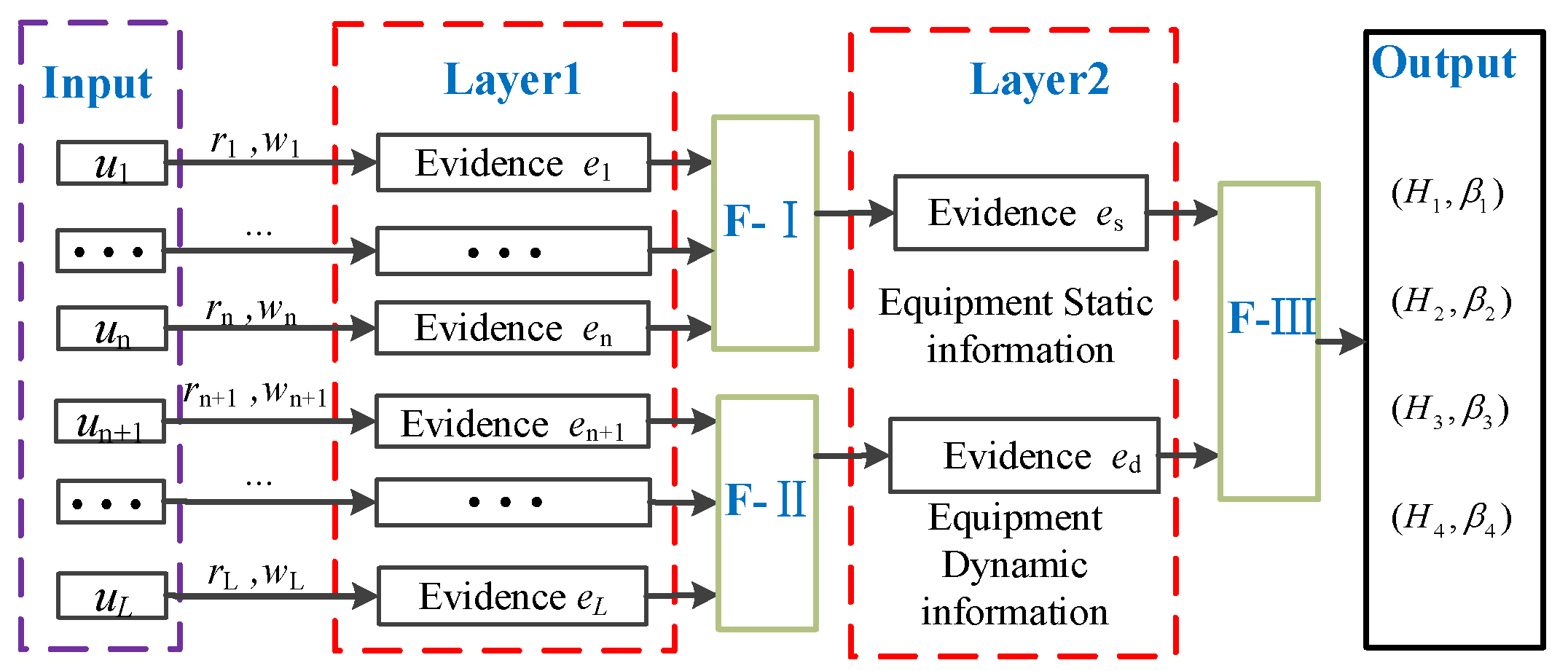



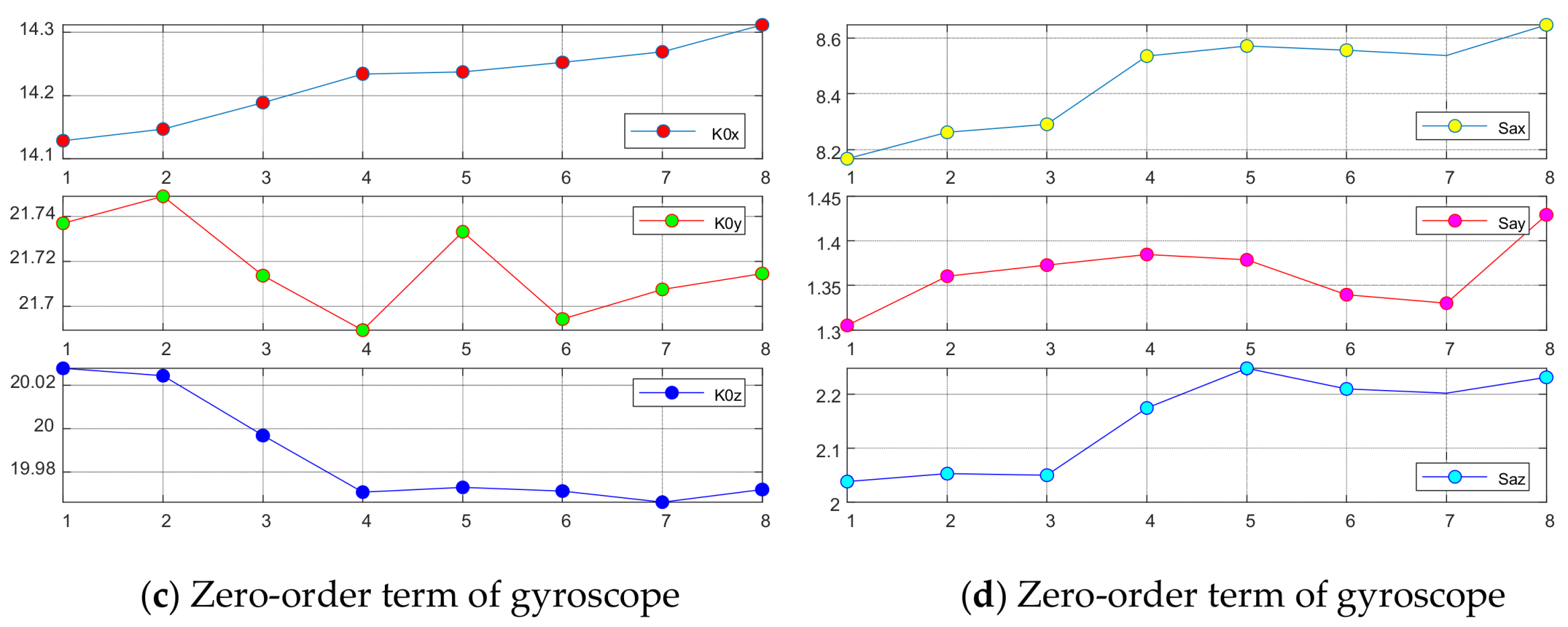


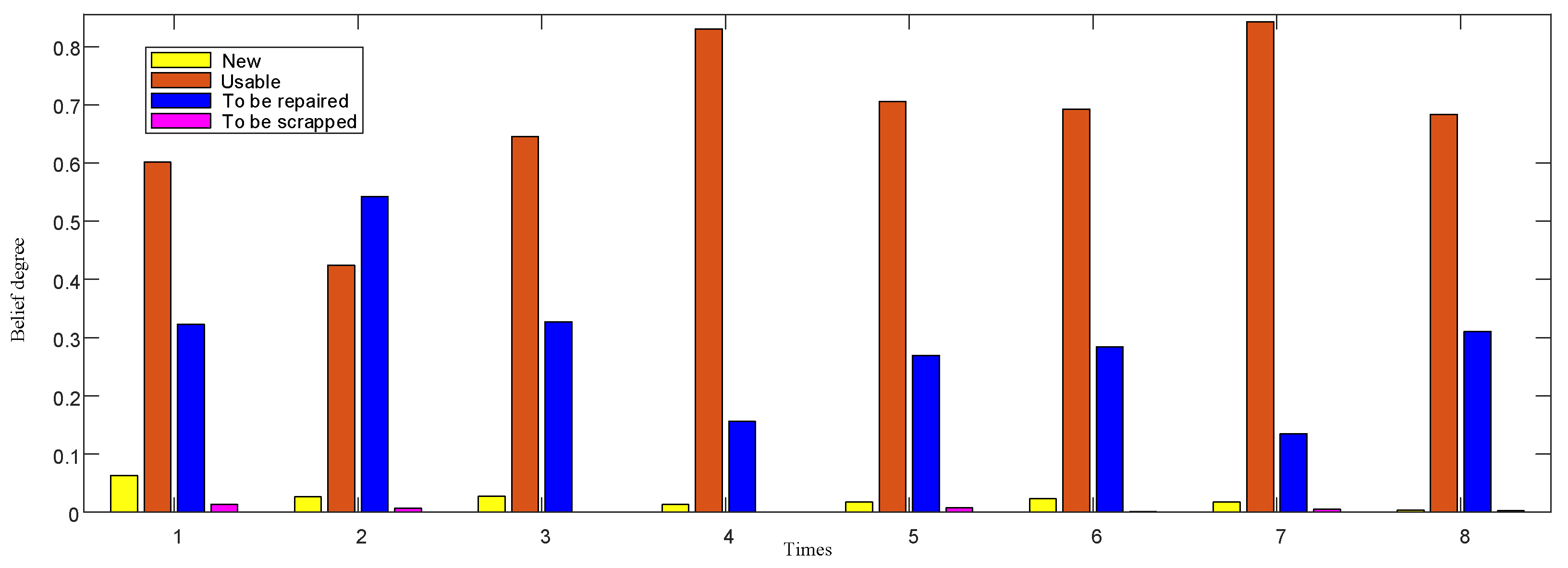
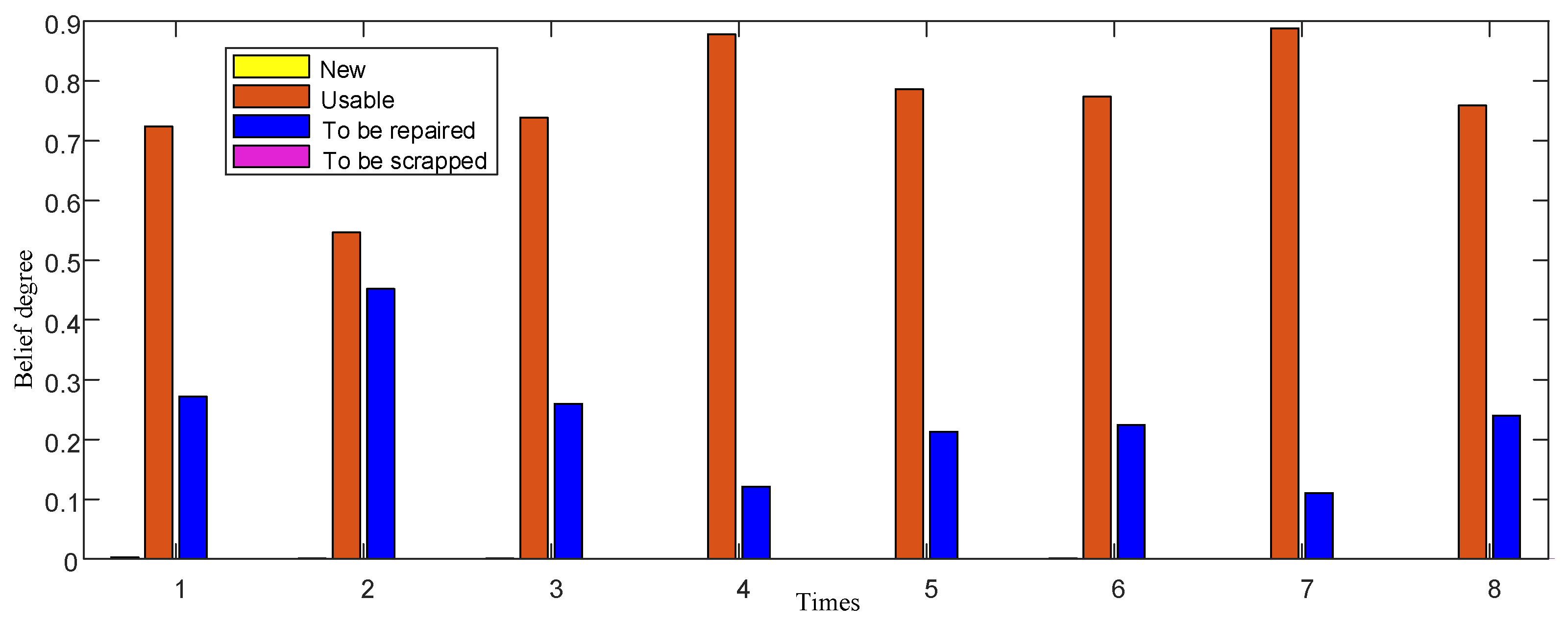
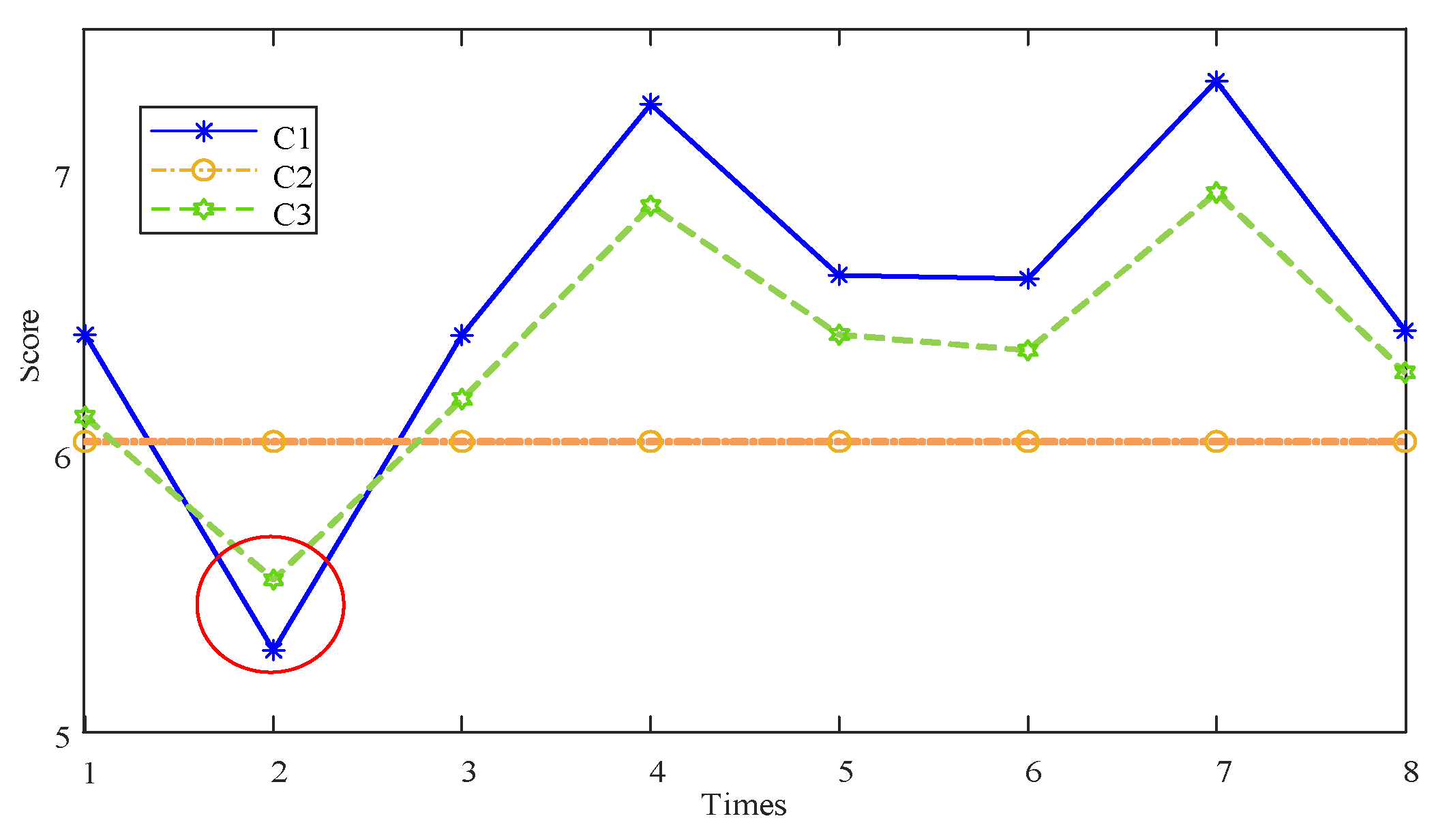
| Maintenance Level | Minor Repairs | Medium Repairs | Major Repairs |
|---|---|---|---|
| Equivalent coefficient | 0.02–0.07 | 0.3–0.5 | 1 |
| Product Serial Number | Maintenance Information/Times | Transport Mileage / km | Enabled Duration/Hour | Effective Length of Service/Hour | |||
|---|---|---|---|---|---|---|---|
| Minor Repair | Medium Repair | Major Repair | Highway | Railway | |||
| 1 | 4 | 2 | 1 | 0.5 | 0.7 | 120 | 5000 |
| Index | (g) | (g) | (g) | (g) | (g) | (g) | (deg/h) |
| 14.0 | 21.6 | 19.90 | 8.0 | 1.30 | 2.0 | 1.00 | |
| 14.3 | 21.7 | 19.98 | 8.3 | 1.35 | 2.1 | 1.25 | |
| 14.7 | 21.9 | 20.02 | 8.8 | 1.45 | 2.2 | 1.75 | |
| 15.0 | 22.0 | 20.05 | 9.0 | 1.50 | 2.3 | 2.00 | |
| Index | (deg/h) | (deg/h) | (deg/h) | (deg/h) | (deg/h) | MI | TM |
| 4.0 | 2.00 | 7.0 | 5.00 | 4.0 | 1.0 | 1.0 | |
| 4.5 | 2.25 | 7.5 | 5.75 | 4.5 | 0.8 | 0.8 | |
| 5.5 | 2.75 | 8.5 | 7.25 | 5.5 | 0.3 | 0.3 | |
| 6.0 | 3.00 | 9.0 | 8.00 | 6.0 | 0.1 | 0.1 |
| ER-1 | Index | Weight | Reliability | ER-2 | Index | Weight | Reliability |
| 0.8 | CVBW | 0.8 | CVBW | ||||
| 0.8 | 0.8 | ||||||
| 0.8 | 0.8 | ||||||
| 0.2 | 0.2 | ||||||
| 0.2 | 0.2 | ||||||
| 0.2 | 0.2 | ||||||
| ER-4 | Index | Weight | Reliability | ER-5 | Index | Weight | Reliability |
| Maintenance information | 1 | Dynamic performance | ER-3 | ||||
| transport mileage | 1 | Static performance |
| Index | ||||
|---|---|---|---|---|
| Static performance of IMU | 0 | 0.6079 | 0.3921 | 0 |
| Appraisal Procedure | ER | BPNN | AHP | FR |
|---|---|---|---|---|
| MSE | 2.610 | 7.118 | 2.950 | 2.653 |
| MAE | 0.808 | 1.334 | 0.859 | 0.814 |
Publisher’s Note: MDPI stays neutral with regard to jurisdictional claims in published maps and institutional affiliations. |
© 2022 by the authors. Licensee MDPI, Basel, Switzerland. This article is an open access article distributed under the terms and conditions of the Creative Commons Attribution (CC BY) license (https://creativecommons.org/licenses/by/4.0/).
Share and Cite
Zhou, X.; Zhou, Z.; Hu, G.; Han, X.; Chen, L. Performance Evaluation of Complex Equipment Considering Resume Information. Entropy 2022, 24, 1811. https://doi.org/10.3390/e24121811
Zhou X, Zhou Z, Hu G, Han X, Chen L. Performance Evaluation of Complex Equipment Considering Resume Information. Entropy. 2022; 24(12):1811. https://doi.org/10.3390/e24121811
Chicago/Turabian StyleZhou, Xiangyi, Zhijie Zhou, Guanyu Hu, Xiaoxia Han, and Leiyu Chen. 2022. "Performance Evaluation of Complex Equipment Considering Resume Information" Entropy 24, no. 12: 1811. https://doi.org/10.3390/e24121811
APA StyleZhou, X., Zhou, Z., Hu, G., Han, X., & Chen, L. (2022). Performance Evaluation of Complex Equipment Considering Resume Information. Entropy, 24(12), 1811. https://doi.org/10.3390/e24121811





